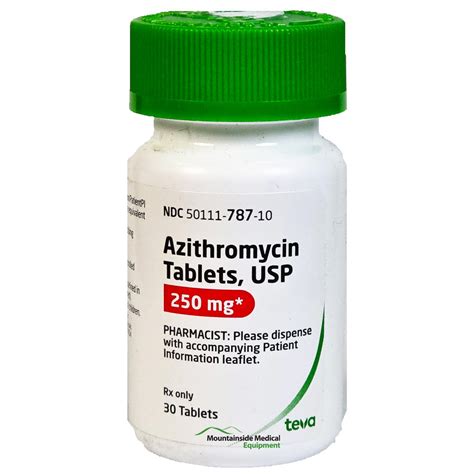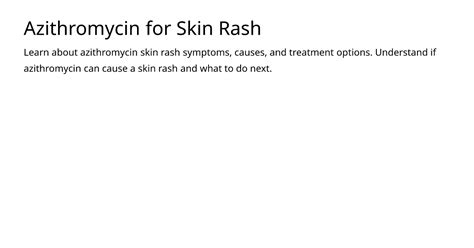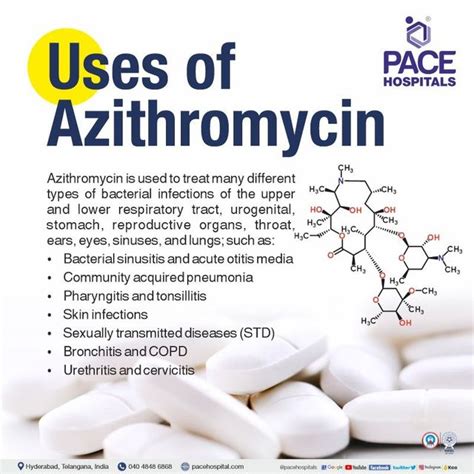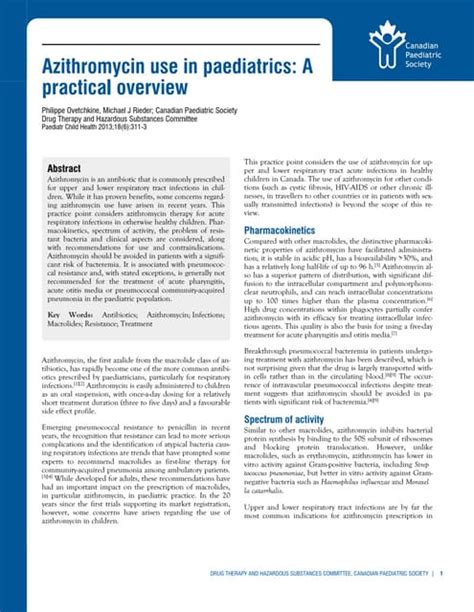Intro
Discover 5 key Azithromycin uses, including treating bacterial infections, respiratory issues, and skin conditions, with this antibiotic medication, exploring its benefits, side effects, and dosage guidelines for effective treatment and prevention of various diseases.
The discovery of antibiotics has revolutionized the field of medicine, enabling doctors to effectively treat bacterial infections that were once deadly. Among the numerous antibiotics available, azithromycin has emerged as a versatile and widely used medication. Its broad spectrum of activity, ease of administration, and relatively mild side effect profile have made it a preferred choice for treating various infections. In this article, we will delve into the different uses of azithromycin, exploring its applications, benefits, and potential risks.
Azithromycin is a macrolide antibiotic, which works by inhibiting protein synthesis in bacteria, ultimately leading to their death. This mechanism of action makes it effective against a wide range of bacterial infections. The drug's pharmacokinetic properties, including its high tissue penetration and long half-life, allow for once-daily dosing and shorter treatment courses compared to other antibiotics. These characteristics have contributed to its popularity among both healthcare providers and patients.
The importance of understanding the various uses of azithromycin cannot be overstated. With the rise of antibiotic resistance, it is crucial to use these medications judiciously, selecting the most appropriate antibiotic for a given infection to ensure effective treatment while minimizing the risk of resistance development. Furthermore, recognizing the potential applications and limitations of azithromycin can help in making informed decisions about its use in different clinical scenarios.
Azithromycin Uses in Respiratory Infections

Azithromycin is commonly used to treat various respiratory infections, including community-acquired pneumonia, acute exacerbations of chronic bronchitis, and acute sinusitis. Its efficacy against common respiratory pathogens, such as Streptococcus pneumoniae, Haemophilus influenzae, and Moraxella catarrhalis, makes it a valuable option for these conditions. The drug's ability to penetrate into respiratory tissues and its long half-life contribute to its effectiveness in treating respiratory infections.
Community-Acquired Pneumonia
Community-acquired pneumonia (CAP) is a significant cause of morbidity and mortality worldwide. Azithromycin is recommended as a first-line treatment for CAP in patients with no recent antibiotic use in the past three months and without risk factors for drug-resistant Streptococcus pneumoniae. Its use in CAP is supported by clinical trials demonstrating its efficacy and safety compared to other antibiotics.Acute Exacerbations of Chronic Bronchitis
Acute exacerbations of chronic bronchitis (AECB) are episodes of increased symptoms, such as cough, sputum production, and shortness of breath, in patients with chronic bronchitis. Azithromycin is effective in treating AECB by targeting the bacterial pathogens responsible for the exacerbation. Its use can help reduce the duration and severity of symptoms, improving the quality of life for patients with chronic bronchitis.Azithromycin Uses in Skin and Soft Tissue Infections

Azithromycin is also used to treat skin and soft tissue infections, including uncomplicated skin and skin structure infections, and uncomplicated genital ulcers. Its activity against Gram-positive cocci, such as Staphylococcus aureus and Streptococcus pyogenes, makes it suitable for these types of infections.
Uncomplicated Skin and Skin Structure Infections
Uncomplicated skin and skin structure infections, such as impetigo, folliculitis, and furuncles, can be effectively treated with azithromycin. The drug's broad spectrum of activity and favorable pharmacokinetic properties allow for short treatment courses, which can improve patient compliance and reduce the risk of antibiotic resistance.Uncomplicated Genital Ulcers
Azithromycin is recommended as a first-line treatment for uncomplicated genital ulcers caused by Haemophilus ducreyi, the bacterium responsible for chancroid. A single dose of azithromycin has been shown to be effective in treating chancroid, offering a convenient and patient-friendly treatment option.Azithromycin Uses in Sexually Transmitted Infections

Azithromycin is used to treat several sexually transmitted infections (STIs), including chlamydia, gonorrhea, and syphilis. Its efficacy against the bacteria responsible for these infections makes it a valuable option for STI treatment.
Chlamydia
Azithromycin is recommended as a first-line treatment for uncomplicated genital chlamydial infections. A single dose of azithromycin has been shown to be effective in treating chlamydia, offering a convenient and patient-friendly treatment option.Gonorrhea
Azithromycin is used in combination with ceftriaxone to treat uncomplicated gonorrhea. This dual therapy approach is recommended due to the increasing prevalence of antibiotic-resistant Neisseria gonorrhoeae strains.Syphilis
Azithromycin is not the first-line treatment for syphilis; however, it can be used as an alternative in patients who are allergic to penicillin. The efficacy of azithromycin in treating syphilis is supported by clinical trials, although resistance to the drug has been reported in some areas.Azithromycin Uses in Other Infections

In addition to its use in respiratory, skin, and sexually transmitted infections, azithromycin is also effective in treating other types of infections.
Pelvic Inflammatory Disease
Azithromycin is used in combination with other antibiotics to treat pelvic inflammatory disease (PID), a condition characterized by inflammation of the female reproductive organs. The drug's activity against the bacteria responsible for PID makes it a valuable option for treatment.Toxoplasmosis
Azithromycin is used as an alternative treatment for toxoplasmosis, a parasitic infection caused by Toxoplasma gondii. The drug's efficacy in treating toxoplasmosis is supported by clinical trials, although it is not the first-line treatment option.Benefits and Risks of Azithromycin

Like all medications, azithromycin has its benefits and risks. The drug's broad spectrum of activity, ease of administration, and relatively mild side effect profile make it a popular choice for treating various infections. However, the risk of antibiotic resistance, potential side effects, and interactions with other medications must be considered when using azithromycin.
Benefits
The benefits of azithromycin include: * Broad spectrum of activity against various bacterial pathogens * Ease of administration, with once-daily dosing and short treatment courses * Relatively mild side effect profile compared to other antibiotics * High tissue penetration, allowing for effective treatment of infections at the site of infectionRisks
The risks associated with azithromycin include: * Risk of antibiotic resistance, particularly with prolonged or unnecessary use * Potential side effects, such as gastrointestinal upset, dizziness, and headache * Interactions with other medications, which can increase the risk of side effects or reduce the efficacy of azithromycinPractical Considerations for Azithromycin Use

When using azithromycin, several practical considerations must be taken into account to ensure effective treatment and minimize the risk of side effects.
Dosage and Administration
The dosage and administration of azithromycin vary depending on the type of infection being treated. The recommended dosage for adults is typically 500 mg on the first day, followed by 250 mg once daily for the remaining days of treatment.Monitoring and Follow-Up
Patients treated with azithromycin should be monitored for signs of improvement or worsening of symptoms. Follow-up appointments may be necessary to assess the effectiveness of treatment and adjust the dosage or treatment regimen as needed.Antibiotic Resistance
The risk of antibiotic resistance must be considered when using azithromycin. To minimize this risk, the drug should only be used when necessary, and the treatment course should be completed as directed.What is azithromycin used for?
+Azithromycin is a macrolide antibiotic used to treat various bacterial infections, including respiratory, skin, and sexually transmitted infections.
How does azithromycin work?
+Azithromycin works by inhibiting protein synthesis in bacteria, ultimately leading to their death. This mechanism of action makes it effective against a wide range of bacterial infections.
What are the benefits of azithromycin?
+The benefits of azithromycin include its broad spectrum of activity, ease of administration, and relatively mild side effect profile. The drug's high tissue penetration and long half-life also contribute to its effectiveness.
What are the risks associated with azithromycin?
+The risks associated with azithromycin include the risk of antibiotic resistance, potential side effects, and interactions with other medications. Prolonged or unnecessary use of the drug can increase the risk of resistance and side effects.
How can I minimize the risk of antibiotic resistance when using azithromycin?
+To minimize the risk of antibiotic resistance, azithromycin should only be used when necessary, and the treatment course should be completed as directed. It is also essential to follow the recommended dosage and administration guidelines.
In conclusion, azithromycin is a versatile antibiotic with a broad spectrum of activity against various bacterial infections. Its ease of administration, relatively mild side effect profile, and high tissue penetration make it a popular choice for treating respiratory, skin, and sexually transmitted infections. However, the risk of antibiotic resistance and potential side effects must be considered when using azithromycin. By understanding the benefits and risks of azithromycin and using the drug judiciously, healthcare providers can effectively treat bacterial infections while minimizing the risk of resistance development. We invite you to share your thoughts and experiences with azithromycin in the comments section below, and we encourage you to share this article with others who may benefit from this information.
